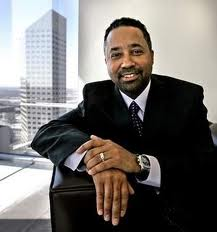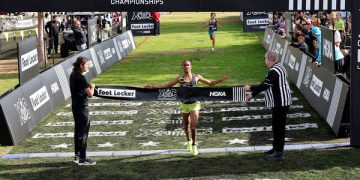
Max Siegel, CEO of USA Track & Field
The pixelated photo above is CEO Max Siegel of USA Track & Field. On Tuesday night’s opening session, December 2, 2014, Max had the job of telling the USATF constituency that USA has beacuoup bucks! Going from $19 million to $35 million in one year, cutting expenditures by $1 million and providing more money to the elite athletes that USATF is focused on developing ($11 million), shows tremendous growth under Mr. Siegel’s tenure.
We asked Elliott Denman to provide his view of the Annual Meeting, and this is the first of three pieces (perhaps more) on the ramifications of the meeting . One final note on this column. Note that Max Siegel noted that there are many things to improve on.
This column was written before the Friday night vote where USATF board voted 11-1, to make Stephanie Hightower the IAAF recommended candidate instead of Bob Hersh.
2014 USATF Annual Meeting
By ELLIOTT DENMAN
ANAHEIM, CALIFORNIA – Success breeds success.
Just ask Max Siegel.
Understand that America’s national track and field federation isn’t – and
probably never will – get to roll around in the world of biggest-time sports megabucks.
But – finally – USA Track and Field is at least a player in the fiscal ballgame.
That was the primary order of business USATF CEO Siegel got to
deliver at the Opening Session of the USATF Annual Meeting at the Anaheim Hilton.
Whereas the administrations of some previous USATF CEOs were marked – well, if
not by flirtations with bankruptcy, but never by opulence, either – there is definite
promise looming just over the horizon.
“Our budgetary expenditures for USATF programs next year will rise by
11 million dollars,” Siegel told his constituency, athletes, coaches, officials, meet organizers and
all other who keep the sport rolling in the USA.
“So we are going from 19 million in terms of program funding to 30 million dollars in our
2015 budget.
“We have (acquired) nine new partnerships since 2012 including two multi-million-dollar long term deals.”
<
div class="MsoNormal" style="margin: 0in 0in 10pt; color: rgb(0, 0, 0); font-family: Arial, Helvetica, sans-serif; font-size: small;"> Whereas the Nike Co. will continue as the governing body’s obviously primary corporate supporter,
the latest pair of sponsors to sign aboard are the Hoka One One brand of shoes and
athletic attire, and the Rosetta Stone brand of language learning systems.
Needing corporate support to build the Occidental Middle Distance Classic meet into a much bigger-time
event, Siegel happily went public with the news that Hoka One One ‘s sponsorship deal will enable the
meet to double its reward purses while providing the biggest month-of-May competitive opportunity for
mid-and-longer distance runners to build their national rankings and assure their spots on the starting line
at the National Championships in Eugene in late June, where the American team bound for the 2015 World
Championships in China will be determined.
Hoka One One? Sure, the Maori-rooted name sounds hokey, but its managers report huge progress in
the short time its track and field gear has been on the market, and they are intent on riding the tide.
Hoka One One nevertheless continues to make major strides in the athletics marketplace. (Editor’s
note: Industry reports note that HOKA ONE ONE is fastest growing running brand
of 2014.)
“We are thrilled that Hoka has made this commitment to the sport and our athletes,” said
Siegel. ” We look forward to a 2015 Hoka One One Middle Distance Classic that is bigger and better than
ever.”
Said Hoka brand president Jim Van Dine, “we are proud to sponsor one of the most important middle
distance meets in the country. While Hoka’s roots started in ultra running, we are very committed to the
sport of track and field, and believe that sponsoring this meet will introduce Hoka to an entirely new
group of track and field athletes and fans.”
The Occidental meet, with events from 800 to 5,000 meters, is expected to feature the cream of the
American crop, all eager for a slice of this newfound pie, the best of the best gearing up for Nationals and
Worlds.
And then there’s the Rosetta Stone contract.
With the planet’s next two biggest meets set for China (the 2015 Worlds in Beijing’s
Bird’s Nest Stadium, of 2008 Olympic fame) and the 2016 Olympic Games in Rio De Janeiro,
USA team members will now be afforded the chance to learn Mandarin Chinese
and Portuguese (the two Olympic home tongues) and thus to be able converse fluently with
the locals on arrival.
Ever notice how all those global tennis players, golfers and skiers – even if they’re from
Serbia, Slovenia or Patagonia – manage to
speak perfect English in their post-victory interviews? Well, thanks to
Rosetta Stone , American athletic travelers will now get
identical linguistic opportunities.
Hopefully, they will take advantage of all this free courseware
being presented them by this sponsorship arrangement.
Of course, it’ not just for the American elites, either.
Rank-and-file USATF members will now be able to sign up for
Rosetta Stone, for a discount, as well.
“These moneys come from private sources, from people who believe in us,”
emphasized Siegel.
“They want commercial value for the money they are investing in our
organization.”
And Siegel & Co.’s job is to assure they get it.
But US Olympic Committee support – as it’s always been – is the biggest of all keys to
USATF’s ongoing promotion of the sport and American athletes.
And, where once the USOC was hugely critical of USATF’s internal operations
and went to so far as to demand wholesale revisions in USATF operational practices – including
total reconfiguration of the USATF Board of Directors – USOC now seems
totally approving of the way USATF is doing things.
“We are happy to report that we are one of the few NGB’s (national governing bodies)
that were fortunate beneficiaries of an increase in our high performance funding which
will go directly to helping our elite athletes, to help us grow our programs and be even more
successful,” said Siegel.
“There are a lot of things we still don’t do right,” he conceded.
But, he emphasized, there’s a lot more being done right than wrong.
“We want to be a better partner with every one of you in this room.”
To which, a whole heck of lot of ‘partners’ applauded the concept.
Thanks to such moves as going nearly totally digital – paper, that’s so passé –
and fine-tuning the travel budget, they’ve already registered over
a million dollars in operating efficiencies.
Should the absolute worst happen, said Siegel, they’d be ready for that, too.
He let out word that there is over “17 million cash” in the
bank to deal with any potential catastrophe.
Hopefully, it’s drawing some seriously appropriate interest.
Larry Eder has had a 52-year involvement in the sport of athletics. Larry has experienced the sport as an athlete, coach, magazine publisher, and now, journalist and blogger. His first article, on Don Bowden, America's first sub-4 minute miler, was published in RW in 1983. Larry has published several magazines on athletics, from American Athletics to the U.S. version of Spikes magazine. He currently manages the content and marketing development of the RunningNetwork, The Shoe Addicts, and RunBlogRun. Of RunBlogRun, his daily pilgrimage with the sport, Larry says: "I have to admit, I love traveling to far away meets, writing about the sport I love, and the athletes I respect, for my readers at runblogrun.com, the most of anything I have ever done, except, maybe running itself." Also does some updates for BBC Sports at key events, which he truly enjoys. Theme song: Greg Allman, " I'm no Angel."
View all posts






















